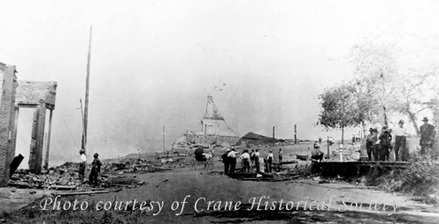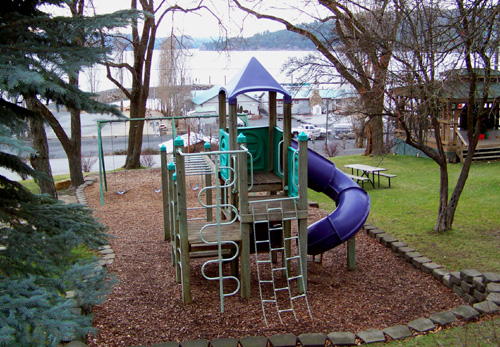1917 Fire in Harrison - A Seething Hell

Aftermath of 1917 fire, Harrison, Idaho, looking north. The triangle shaped debris in center of photo was what was left of the Masonic Temple (current Grant Building). The two men at left are looking at the remnants of Brown's Store, where the "One Shot's Building" now stands. To their right is the area where 11 buildings burned and were never rebuilt. This is where Harrison City Park is now.
A Devastating Blow
The citizens of Harrison suffered a devastating blow on July 21, 1917, when fire broke out at the Grant Lumber Co. and burned much of the town. Sparks blew uphill to the business district and landed on cloth awnings, wooden sidewalks and dry timber frame buildings. Firefighters were hampered by thousands of rounds of ammunition exploding at hardware stores. Townspeople tried to slow the blaze by ripping the wooden sidewalks up. Despite everyone's best efforts, the town became engulfed in a conflagration the Spokane Daily Chronicle called a burning and seething hell. A pall of grim gray smoke hangs over the town day and night. No human power can stop the blaze, say the timbermen. -- Spokane Daily Chronicle Twenty-seven years of progress were destroyed in ninety minutes as 40 businesses, 4 churches, 2 meeting halls and 23 homes burned. The water works, utility company, and city clerk's office were destroyed, along with the town's records.
Dozens of war gardens were ruined. In an orchard the apples were baked almost perfectly on the trees. At one house the hot water tank exploded with such force that the piping was thrown against a small tree so fast it wrapped itself twice around the trunk. The water in the fire hoses slowed to a drizzle and the hoses burned up. |
Governor Declares Martial Law
Governor Alexander arrived to inspect the scene and concluded the fire was caused by a spark from a locomotive, even though there had not been an engine down the track within an hour before the blaze began. Then he placed Harrison under martial law and quickly left town Union Unrest The governor's actions fueled residents' suspicions that the blaze had been set by union sympathizers and the government was afraid a probe might uncover the truth. 1917 was the height of union unrest in the lumber industry, and International Workers of the World organizers were fanned out all over the woods agitating to reform crude and unsanitary working conditions in the lumber camps. Tempers were running high up the river in St. Maries, where a contingent of Wobblies was clashing with anti-union vigilantes. The townspeople firmly believed the fire in Harrison was arson by Wobblies or a disgruntled employee. The next morning, businessmen found temporary spaces for their shops. Some worked out of tents while they rebuilt. Others gave up and moved on. The commercial core that developed after 1917 was considerably smaller than its early incarnation. After the fire merchants constructed buildings with brick and hollow tile. Within a year of the fire, five new brick buildings housed six businesses, a movie theater, post office, and lodge hall. A sixth brick building, the Masonic Temple, was completed the following year.
Note: Crane Historical Society photos are available for purchase. Drop them a line or stop by the Crane House Museum during visitor hours.
|


